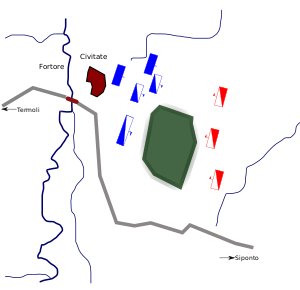Battle of Civitate
| Battle of Civitate | |||||||
|---|---|---|---|---|---|---|---|
 Battle plan of the Battle of Civitate. Red: Normans. Blue: Papal coalition. |
|||||||
|
|||||||
| Belligerents | |||||||
| Normans | Papal coalition Swabians, Italians, Lombards |
||||||
| Commanders and leaders | |||||||
|
Humphrey of Hauteville Robert Guiscard Richard Drengot |
Rudolf of Benevento Gerard, Duke of Lorraine |
||||||
| Strength | |||||||
| 3,000 horsemen c. 500 infantry |
c. 6,000, infantry and horsemen | ||||||
The Battle of Civitate (also known as Battle of Civitella del Fortore) was fought on 18 June 1053 in southern Italy, between the Normans, led by the Count of Apulia Humphrey of Hauteville, and a Swabian-Italian-Lombard army, organised by Pope Leo IX and led on the battlefield by Gerard, Duke of Lorraine, and Rudolf, Prince of Benevento. The Norman victory over the allied papal army marked the climax of a conflict between the Norman mercenaries who came to southern Italy in the eleventh century, the de Hauteville family, and the local Lombard princes. By 1059 the Normans would create an alliance with the papacy, which included a formal recognition by Pope Nicholas II of the Norman conquest in south Italy, investing Robert Guiscard as Duke of Apulia and Calabria, and Count of Sicily.
The Normans had arrived in Southern Italy in 1017, in a pilgrimage to the sanctuary of St. Michael Archangel in Monte Sant'Angelo sul Gargano (Apulia). These warriors had been used to counter the threat posed by the Saracens, who, from their bases in Sicily, raided South Italy without much resistance from the Lombard and Byzantine rulers of the affected lands.
The availability of this mercenary force (the Normans were famous for being militariter lucrum quaerens, "seeking wealth through military service") could not escape the notice of the Christian rulers of Southern Italy, who employed the Normans in their internal wars. The Normans took advantage of this turmoil; in 1030, Rainulf Drengot obtained the County of Aversa.
...
Wikipedia
